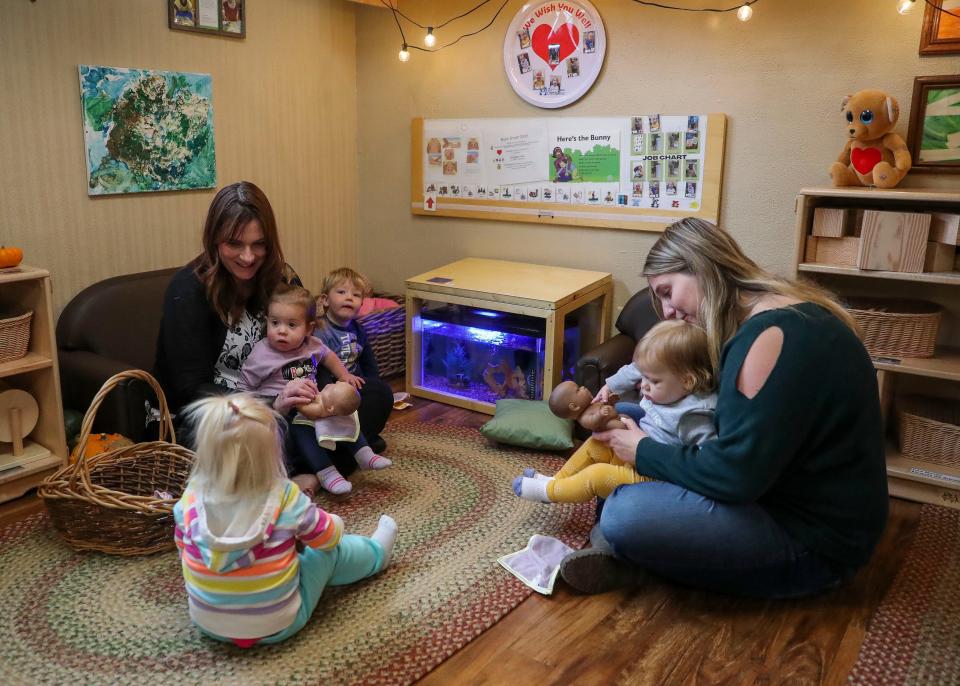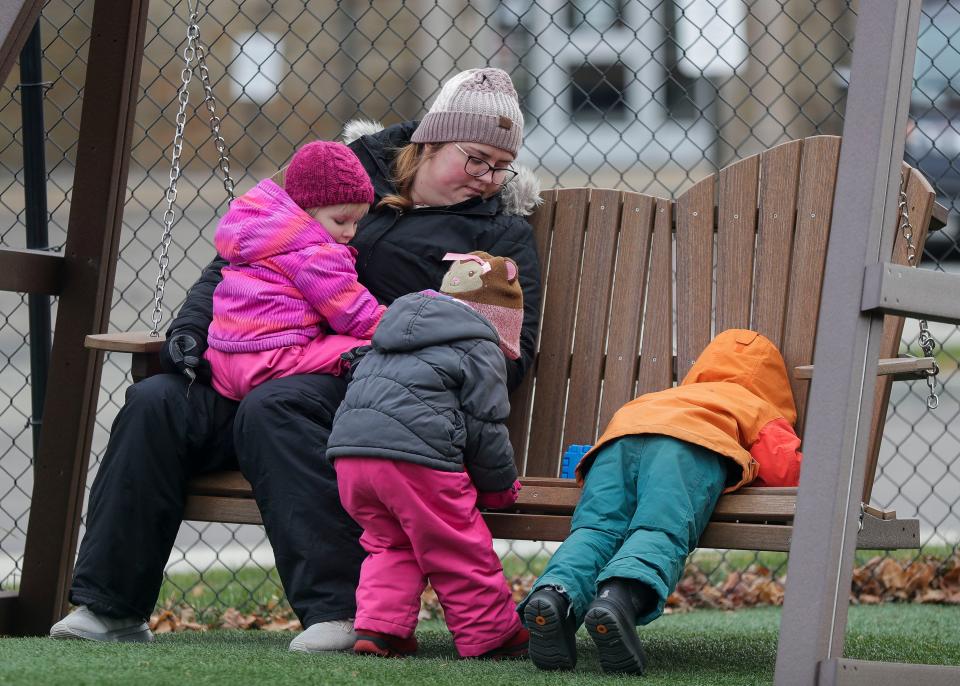How Portage County leaders are teaming up to battle the child care crisis
Portage County business leaders, economic experts, government officials and those in the child care industry have partnered to seek a solution to the county’s growing shortage of available child care.
Dubbed the “Dream Big” Child Care Coalition, the group is working to support the county’s regulated child care businesses and eventually find sustainable solutions to the child care crisis. They hope to secure multiple funding opportunities, such as pandemic relief from the county and the Wisconsin Department of Children and Families’ Dream UP! Grant Program.
Childcaring Inc. Executive Director Kelly Borchardt said the latter would “enhance” the Coalition’s efforts through funding and strategic planning support. She said the Coalition’s name is an homage to the grant.
A recent survey of approximately 900 Portage County employees distributed by KinderCare, a nationwide child care company that also has services to help employers find child care solutions, found over 100 employees anticipated starting a family or having additional children in the next two years. Nearly 30% said they thought about leaving their jobs due to child care concerns within the past year, and almost 40% said they believed a lack of child care resources had affected their work performance at some point. The survey was sparked by Stevens Point book printer Worzalla's efforts to address the child care crisis.
“When you look at lost productivity, that was really eye opening,” said Sue Matis, Coalition co-chair and vice president of People Operations for Skyward Inc.
More:Ariens built a center in Brillion to provide subsidized daycare to employees. It's working.
More:The statewide labor shortage could last years. Here's how employers, workers can still succeed

Parents struggle to find affordable child care
Little Sneakers Family Day Care Owner Mary Olson said when she first started her licensed child care out of her Stevens Point home in 1989, Portage County alone had nearly 50 in-home day cares like hers. Now, family child cares represent just 20 of the county’s total 47 regulated child care options, according to the state’s child care finder website.
“When people were looking for day care, they made a decision (between) family day care or group day care. They got to pick and choose based on our philosophies and how we ran our day cares,” Olson said. “Nowadays, parents are calling and they’re not even asking if I have openings, they’re calling and saying, ‘Can I just get on the waitlist?’ because they know there are no openings here, and there probably won’t be for two years. I already have all my slots for next year filled.”

The shortage of care is not just limited to the family child care sector. According to DCF data from early 2022, 62% of Portage County’s zip codes are considered child care deserts – areas with at least 30 children under the age of 5 where there are at least three children in this age range for every one regulated child care slot.
With such scarce supply of care, it’s no surprise waitlists like Olson mentioned are commonplace among both centers and home-based child cares. In September, Childcaring Inc. surveyed the county’s group centers that provide full-day care for children of all ages and found wait times ranged up to 9 months for a 3 year old, up to a year for a 2 year old and up to two years for an infant, with some centers saying they may never have openings.
“You would have to reserve your slot before you get pregnant in some cases,” said Rob Manzke, Coalition co-chair and University of Wisconsin-Stevens Point chief of staff and legislative liaison.
Becky Helf, director of the UWSP Child Learning and Care Center, who's also the Portage County child care provider support contact and a Coalition member, said she has seen cases where parents on waitlists will still accept a child care slot opening even if they are still on maternity or paternity leave, meaning they pay for weeks, or even months, of care that their child is not there to reserve their slot.
But, planning so far in advance isn’t always possible, said Carol Mishler, program coordinator of Parents, Family and Community Engagement for CAP Services.
“If you’re low income or you have a pretty chaotic life, it’s unlikely that you’re going to be able to think like that, so (finding care) can be even more complicated for those folks,” Mishler said.
More:Here's how Calumet County is trying to help its child care providers survive
For those lucky enough to secure care, it’s at a steep cost. According to a 2019 Child Care Aware of America report, infant care in Portage County averages between 9.3-12.3% of the average married couple’s household income, depending on if the child is enrolled in a family child care or center. For Portage County married couples with a 4 year old, they can expect to devote between 9.1% and 10.9% of their income to child care.
Yet, the U.S. Department of Health and Human Services considers child care to be affordable if it costs families 7% or less of their household income.
“Affordability is a huge issue for care,” Borchardt said. “Finding it is one hurdle, but then can you afford it?”
Staffing shortages drive child care crisis
The number one issue facing child care providers is the lack of adequate staffing.
Portage County centers that serve all ages full time need to hire a total of nearly 90 individuals in order to be fully staffed, according to a Childcaring Inc. survey done in October.
For child care centers, staffing shortages are particularly insidious. Because centers must abide by child-to-staff ratio requirements that vary based on children’s ages, being short staffed often means they cannot operate at their full licensed capacity. This means that just because child care desert data states there are a certain number of slots in a community it doesn’t mean all of these slots can be filled, making the child care shortage even more dire.
Because of staffing shortages, child care center workers often work overtime to cover unfilled shifts and pull directors away from their administrative duties to run classrooms. When this is not possible or no longer sustainable, they are forced to close entire classrooms or reduce service hours.
The same survey found there were over 190 unfilled slots in these centers, Borchardt said. Most – if not all – of this can be attributed to staffing issues.
More:Staffing crisis forcing some Fox Cities child cares to 4-day week, fewer children
There are many factors that contribute to the child care worker staffing shortage, possibly the largest factor being low pay with little – if any – job benefits. A March 2021 report from Childcaring Inc. found the average pay for an assistant child care teacher in Portage County is $10.55, with the average pay for a lead teacher at $13.42.
For family child care providers in Wisconsin, the average wage is $7.46.
These wages are often capped by the maximum parents can pay for care, meaning they are not easily increased.
While most child care providers have some degree of higher education they make far less than the average Wisconsin worker with a high school diploma. All industries combined, the average wage for a Wisconsin worker who completed high school is $15.87.

Helf said because the Child Learning and Care Center staff receive perks of being state employees – better salaries, a strong benefits package and professional development opportunities she finds wards off burnout – they are able to be fully staffed and therefore operate at full capacity.
“We are a rare exception to the norm and even then our staff still have their struggles,” Helf said.
It’s not that child care business owners want to pay their employees little – often they don’t have much of a choice. For a long time, child cares’ sole revenue source was the price parents paid for care, and by the time all other costs are taken out, little is left for wages. Should businesses increase their tuition, they risk pricing families out of the market.
Starting points for change
With a number of upcoming funding opportunities on their radar, such as the Portage County State and Local Fiscal Recovery Funds Program, the Coalition has started to form potential strategies to address multiple aspects of the crisis they’ve been examining. Here’s what is at the top of their list, Helf said:
Recruitment and retention efforts: This could include hiring a recruitment specialist that visits high schools and colleges to encourage students to enter the child care profession. Helf said working with local technical colleges to design a pathway program to make it easier for students to enter the field is another possibility, along with offering retention bonuses to support existing child care staff.
Child mental health guidance: In response to the increased prevalence of children struggling with mental and behavioral health concerns, the Coalition is considering onboarding "inclusion specialists." These child development and early intervention professionals would mentor and coach child care staff in how to address challenging behaviors, as well as intervene when necessary. Helf said their purpose is twofold: to help children and families who are struggling, and to retain child care staff by offering support.
Encourage businesses to aid employees with child care: Helf said the coalition is considering potential models that would help employers invest in their workers’ child care needs. This could be similar to the Department of Children and Families’ Partner UP grant, in which together the grant and businesses fund care at existing regulated child cares for their employees.
“The goal (of these strategies) ultimately is to get the child care programs within the county to be able to operate at their maximum licensed capacity, which will then help families so they can ideally return to the workforce,” Helf said.
Those interested in learning more about the Coalition should contact Childcaring Inc. at 715-841-9490 or the United Way of Portage County at 715-341-6740.
Madison Lammert is a Report for America corps member who covers child care and early education for USA TODAY NETWORK-Wisconsin. Contact her at mlammert@gannett.com or 920-993-7108. Follow on Twitter @MadisonLammert0.
You can directly support her work with a tax-deductible donation online at http://bit.ly/Appleton_RFA or by check made out to The GroundTruth Project with subject line Report for America Post Crescent Campaign. Address: The GroundTruth Project, Lockbox Services, 9450 SW Gemini Dr, PMB 46837, Beaverton, Oregon 97008-7105.
This article originally appeared on Stevens Point Journal: Portage County leaders are teaming up to battle the child care crisis

